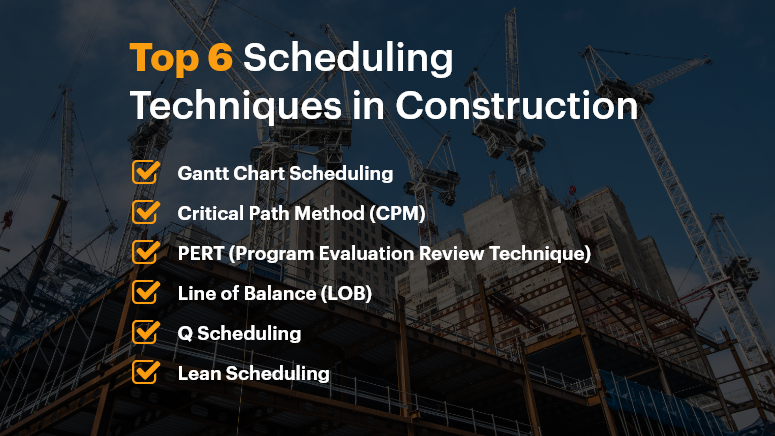Construction is complex, and without a proper schedule, it’s chaos waiting to happen. Did you know that 98% of mega construction projects face delays or cost overruns? Even smaller projects can derail without a strong scheduling system in place.
The truth is, every successful build — whether it’s a residential home or a commercial complex — starts with an accurate, realistic, and adaptive schedule.
In this guide, we’ll break down the top construction scheduling techniques, show you when to use them, and how digital tools like OConstruction’s project management software simplify the entire process.
Whether you’re managing one project or fifteen, these methods will help you stay ahead, reduce risk, and deliver on time, every time.
Why Construction Scheduling Techniques Matter for Modern Teams
Proper construction scheduling isn’t just about dates and tasks. It’s about predictability, accountability, and profitability.
Construction projects involve multiple moving parts: labor, permits, deliveries, inspections, client approvals, weather dependencies, and more. Without robust scheduling techniques, projects often slip into reactive mode, causing:
- Missed deadlines and penalties
- Cost overruns due to rework and inefficiencies
- Poor client satisfaction and damaged reputation
Scheduling is no longer a back-office admin job — it’s a strategic advantage.
Who Benefits Most?
- Project managers gain clear visibility into timelines, delays, and task dependencies
- Contractors and site engineers know exactly when crews, materials, and vendors are scheduled
- Executives and clients get transparency on project milestones and delivery status
- Operations teams can plan better across multiple sites using live data
In industries like real estate development, infrastructure, interior design, and EPC, mastering construction scheduling techniques leads to faster delivery and lower costs.

Best Practices, Frameworks, and Scheduling Techniques
Let’s explore the most effective scheduling techniques, common pitfalls to avoid, and how to implement them efficiently with tools like OConstruction.
Do’s and Don’ts of Construction Scheduling
- Use visual tools like Gantt charts: Gantt charts provide a timeline-based visual layout that shows start/end dates, dependencies, and milestones. These are ideal for stakeholder communication and progress tracking.
- Don’t build a schedule without buffer times: Things will go wrong — delays in delivery, weather issues, labor shortages. Building in contingency helps you stay realistic and flexible.
- Align the schedule with resource availability: Scheduling without resource coordination leads to idle time or overbooking. Use platforms that integrate resource planning and project timelines.
- Don’t treat your schedule as static: Construction schedules should evolve with the project. Use software that allows real-time updates and mobile syncing for your field teams.
Quick Wins for Better Scheduling
- Adopt cloud-based scheduling tools
Spreadsheets get outdated fast. Cloud-based systems let teams access and edit schedules from anywhere, with changes synced in real time.
- Define task dependencies clearly
Use the Predecessors and Successors logic to avoid task conflicts and idle waiting. Tools like OConstruction allow drag-and-drop Gantt charts to manage these visually.
- Integrate schedules with your procurement and budget plans
When material delivery or payment approvals are disconnected from the schedule, delays happen. Choose a unified platform that ties them together.
- Use mobile apps for field updates
Let site supervisors mark task completion or flag delays from their phones. This ensures your schedule reflects the actual ground reality.
Step-by-Step Framework: Choosing the Right Scheduling Technique
1. Gantt Chart Scheduling
Ideal for: Small to mid-size projects with linear workflows
Visualize each task along a timeline. Helps communicate progress to clients and track dependencies easily.
2. Critical Path Method (CPM)
Ideal for: Complex builds with tight deadlines
Identifies the longest stretch of dependent activities and highlights the minimum project duration. Perfect for tracking what’s most likely to delay delivery.
3. Program Evaluation Review Technique (PERT)
Ideal for: Projects with uncertainty in task duration
Uses optimistic, pessimistic, and most likely timelines to calculate expected durations. Useful in early planning stages.
4. Line of Balance (LOB)
Ideal for: Repetitive workflows like high-rise floors or housing units
Visualizes task repetition across segments to balance resources and avoid bottlenecks.
5. Q Scheduling (Quantitative Scheduling)
Ideal for: Resource-heavy projects
Focuses on quantities of work per task per period, linking material usage directly with the schedule.
6. Lean Construction Scheduling (Last Planner System)
Ideal for: Agile, collaborative environments
Encourages weekly planning and real-time coordination with field teams. Perfect for reducing waste and improving flow.
Each of these construction scheduling techniques has its use case. The smart move is using a platform like OConstruction, which supports multiple techniques and adapts to your project type.
Customer Story: Turning Chaos into Clarity
For example, TitanStruct Infra, a mid-size infrastructure firm, used OConstruction’s Gantt-based scheduling module combined with real-time field reporting to manage six highway expansion projects across two states.
Here’s how it helped:
- Used the critical path method to highlight high-risk delays
- Integrated project timelines with vendor delivery schedules
- Allowed site engineers to update task statuses via mobile
- Enabled management to visualize milestone progress in a single dashboard
Outcome:
- 35% improvement in schedule adherence
- 25% less idle time across teams
- Faster decision-making with real-time delay alerts
That’s the power of combining construction scheduling techniques with smart software.
Key Takeaways: From Delay-Prone to Deadline-Driven
- Scheduling is the strategic core of successful construction project management
- Choose the right technique based on project size, complexity, and team structure
- Tools like OConstruction turn theory into execution with drag-and-drop Gantt charts, mobile updates, and critical path analysis
- Standardize your approach, but stay agile with real-time data
With the right methods and the right platform, you’ll always be on time and on budget.
FAQs
1. What is construction scheduling and why is it important?
Construction scheduling is the process of planning, organizing, and tracking tasks, resources, and timelines to ensure projects are delivered on time and within budget. It prevents delays, cost overruns, and miscommunication among teams.
2. Which construction scheduling technique is best for small projects?
For small to mid-sized projects, Gantt chart scheduling is the most effective. It visually shows timelines, dependencies, and milestones in a simple way — making it easy to communicate with clients and track progress.
3. How does the Critical Path Method (CPM) help in construction projects?
CPM identifies the longest chain of dependent tasks, highlighting the activities that directly impact the project’s delivery date. This helps managers prioritize critical tasks and avoid project delays.
4. When should I use PERT instead of CPM?
Use PERT when project tasks involve uncertainty in duration (e.g., early-stage planning or projects with many unknowns). PERT accounts for optimistic, pessimistic, and most-likely timelines, while CPM works better with fixed durations.
5. What is Line of Balance (LOB) scheduling used for?
LOB is ideal for repetitive tasks such as high-rise construction or housing projects. It ensures smooth sequencing and resource allocation across repeated tasks, reducing bottlenecks.





